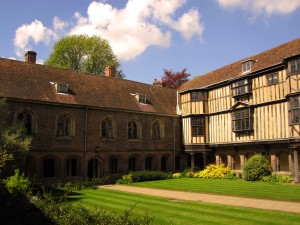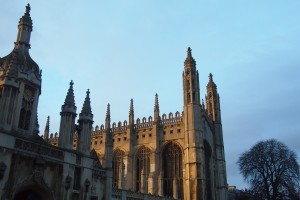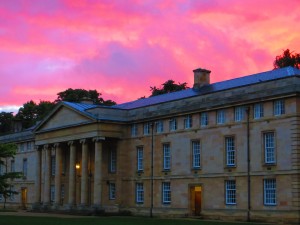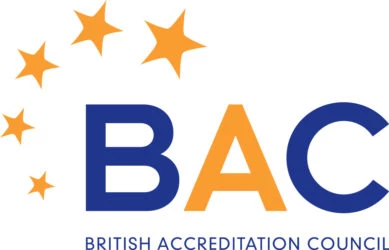Cambridge is consistently called one of the most beautiful cities in the world. This is in large part because of the breathtaking architecture – many very, very old buildings have survived and remain in use, and architectural innovation has continued right up to the present day. Cambridge is therefore the perfect setting for an introduction to architecture summer program.
 Cambridge University dates back over 800 years to 1209. However, there are buildings in Cambridge that date back earlier, and the city developed over time, with new buildings created, and sometimes old buildings altered, using styles from different periods in history. We’ll take a look at some of the best examples of the beautiful and varied architecture to be found in the historic city of Cambridge.
The Round Church
One of the oldest buildings in Cambridge is the Round Church, a Norman structure which dates back all the way to 1130 AD. This longstanding structure is a brilliant example of the different architectural styles through the ages. Originally, the shape of the church was modeled on the Holy Sepulchre in Jerusalem, with the church itself being of Norman design. Quite extensive rebuilding of the inside of the church occurred in the 13th Century. In the 15th Century, changes were made to make the building more Gothic, including the addition of carvings of angels, and the Norman windows changed for Gothic style windows. During the course of the English Civil War, any idolatrous images were destroyed. The Victorian’s added stained glass windows, though these were destroyed during the Second World War. The Church you see now looks closer to its Norman original, as a huge and expensive restoration of the building was necessary after the church fell into disrepair in the 19th Century.
Kings College Chapel
This chapel is one of the most famous buildings in the world, and arguably the most iconic building in Cambridge – during our international study program, students live within walking distance of it. The chapel was built over a period of 100 years, from the Middle Ages to Tudor Times, as wars and money prevented its completion. The building of King’s Chapel was presided over by four kings, and four masons.
Cambridge University dates back over 800 years to 1209. However, there are buildings in Cambridge that date back earlier, and the city developed over time, with new buildings created, and sometimes old buildings altered, using styles from different periods in history. We’ll take a look at some of the best examples of the beautiful and varied architecture to be found in the historic city of Cambridge.
The Round Church
One of the oldest buildings in Cambridge is the Round Church, a Norman structure which dates back all the way to 1130 AD. This longstanding structure is a brilliant example of the different architectural styles through the ages. Originally, the shape of the church was modeled on the Holy Sepulchre in Jerusalem, with the church itself being of Norman design. Quite extensive rebuilding of the inside of the church occurred in the 13th Century. In the 15th Century, changes were made to make the building more Gothic, including the addition of carvings of angels, and the Norman windows changed for Gothic style windows. During the course of the English Civil War, any idolatrous images were destroyed. The Victorian’s added stained glass windows, though these were destroyed during the Second World War. The Church you see now looks closer to its Norman original, as a huge and expensive restoration of the building was necessary after the church fell into disrepair in the 19th Century.
Kings College Chapel
This chapel is one of the most famous buildings in the world, and arguably the most iconic building in Cambridge – during our international study program, students live within walking distance of it. The chapel was built over a period of 100 years, from the Middle Ages to Tudor Times, as wars and money prevented its completion. The building of King’s Chapel was presided over by four kings, and four masons.
 The first stone was laid in 1446 by Henry VI, who envisioned a chapel unequalled in scale and beauty. The War of the Roses hindered progress – Henry was eventually imprisoned by his enemy Richard Duke of York, and killed in 1471. Under the new monarch, King Edward, little progress was made. After his death, the next king, Richard III, was much more invested in the building, and a lot more work was done. Richard III was killed in the Battle of Bosworth by Henry VI, who initially ignored the chapel until he visited Cambridge, and his mother told him to finish the work begun by his uncle, Henry VI. Money was left in his will for continued work, and the building was completed under the reign of Henry VIII.
Harvey Court
Home to many First Years studying at Gonville and Caius College, Harvey Court is a Grade II* listed building completed in 1962. It’s beauty is controversial – many are not so sure how aesthetically pleasing the building really is. However, the significance of its design is unquestionable, and it was radical for 1960s Cambridge. Harvey Court is now used as an example of brilliant architecture by the university’s fellows, and is often visited by those interested in building design.
Faculty of Law
One of the newer editions to Cambridge, the Faculty of Law houses the university’s law school and Squire Law Library. It opened in 1996, and was designed by renowned architect Norman Foster. He also designed one of London’s most famous buildings – 30 St Mary Axe, or ‘The Gherkin’ as it is much more commonly known.
Norman Foster wanted the building to combine tradition and innovation, a reflection of the university’s ethos. Incredibly different to the intricate stone-work and design of many of the university’s buildings, one whole side of the Faculty of Law is made of glass. This creates a lot of natural light, one of the ways that the building prioritizes energy efficiency.
The first stone was laid in 1446 by Henry VI, who envisioned a chapel unequalled in scale and beauty. The War of the Roses hindered progress – Henry was eventually imprisoned by his enemy Richard Duke of York, and killed in 1471. Under the new monarch, King Edward, little progress was made. After his death, the next king, Richard III, was much more invested in the building, and a lot more work was done. Richard III was killed in the Battle of Bosworth by Henry VI, who initially ignored the chapel until he visited Cambridge, and his mother told him to finish the work begun by his uncle, Henry VI. Money was left in his will for continued work, and the building was completed under the reign of Henry VIII.
Harvey Court
Home to many First Years studying at Gonville and Caius College, Harvey Court is a Grade II* listed building completed in 1962. It’s beauty is controversial – many are not so sure how aesthetically pleasing the building really is. However, the significance of its design is unquestionable, and it was radical for 1960s Cambridge. Harvey Court is now used as an example of brilliant architecture by the university’s fellows, and is often visited by those interested in building design.
Faculty of Law
One of the newer editions to Cambridge, the Faculty of Law houses the university’s law school and Squire Law Library. It opened in 1996, and was designed by renowned architect Norman Foster. He also designed one of London’s most famous buildings – 30 St Mary Axe, or ‘The Gherkin’ as it is much more commonly known.
Norman Foster wanted the building to combine tradition and innovation, a reflection of the university’s ethos. Incredibly different to the intricate stone-work and design of many of the university’s buildings, one whole side of the Faculty of Law is made of glass. This creates a lot of natural light, one of the ways that the building prioritizes energy efficiency.
 Our Cambridge summer courses are run within walking distance of all these buildings, and all our students stay in colleges with interesting architectural histories and differences. Just walking the streets of the city centre, students will see the stunning examples of architecture which make Cambridge such a beautiful and unique place to be. If you want to learn more about architecture, with one of the most architecturally rich and diverse cities at your fingertips, then our residential summer school is for you. Equally, if you want a study trip abroad to an interesting, vibrant, and charming city, then apply to Reach Cambridge.
Our Cambridge summer courses are run within walking distance of all these buildings, and all our students stay in colleges with interesting architectural histories and differences. Just walking the streets of the city centre, students will see the stunning examples of architecture which make Cambridge such a beautiful and unique place to be. If you want to learn more about architecture, with one of the most architecturally rich and diverse cities at your fingertips, then our residential summer school is for you. Equally, if you want a study trip abroad to an interesting, vibrant, and charming city, then apply to Reach Cambridge.

Queens’ College President’s Lodge

View of King’s Chapel

The stunning Downing College







